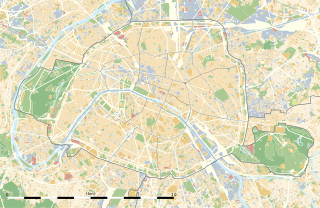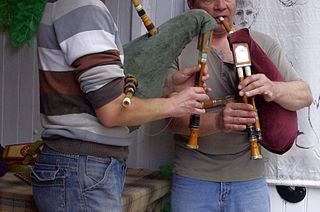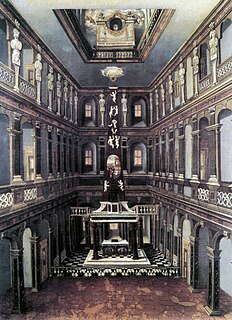
The Louvre, or the Louvre Museum, is the world's largest art museum and a historic monument in Paris, France. A central landmark of the city, it is located on the Right Bank of the Seine in the city's 1st arrondissement. Approximately 38,000 objects from prehistory to the 21st century are exhibited over an area of 72,735 square meters. In 2019, the Louvre received 9.6 million visitors.

Toulouse is the capital of the French department of Haute-Garonne and of the region of Occitanie. The city is on the banks of the River Garonne, 150 kilometres from the Mediterranean Sea, 230 km (143 mi) from the Atlantic Ocean and 680 km (420 mi) from Paris. It is the fourth-largest city in France, with 466,297 inhabitants as of January 2014. In France, Toulouse is called the "Pink City".
The gigue or giga is a lively baroque dance originating from the Irish jig. It was imported into France in the mid-17th century and usually appears at the end of a suite. The gigue was probably never a court dance, but it was danced by nobility on social occasions and several court composers wrote gigues.
The Goldman Environmental Prize is a prize awarded annually to grassroots environmental activists, one from each of the world's six geographic regions: Africa, Asia, Europe, Islands and Island Nations, North America, and South and Central America. The award is given by the Goldman Environmental Foundation headquartered in San Francisco, California. It is also called the Green Nobel.

The du Pont family is a prominent American family descended from Pierre Samuel du Pont de Nemours (1739–1817). The du Pont family has been one of the richest families in America since the mid-19th century, when it founded its fortune in the gunpowder business. In the late 19th and early 20th centuries, it expanded its wealth through the chemical industry and the automotive industry, with substantial interests in the DuPont company, General Motors, and various other corporations.

Albergaria-a-Velha is a town and a municipality in the Aveiro District in Portugal. The population in 2011 was 25,252, in an area of 158.83 km². It had 19,687 eligible voters in 2006.
Tonguing is a technique used with wind instruments to enunciate different notes using the tongue on the reed or woodwind mouthpiece or brass mouthpiece. A silent "tee" is made when the tongue strikes the reed or roof of the mouth causing a slight breach in the air flow through the instrument. If a more soft tone is desired, the syllable "da" is preferred. The technique also works for whistling. Tonguing also refers to articulation, which is how a musician begins the note and how the note is released For wind players, articulation is commonly spoken of in terms of tonguing because the tongue is used to stop and allow air to flow in the mouth. Tonguing does not apply to non wind instruments, but articulation does apply to all instruments.

French bagpipes cover a wide range and variety of styles of bagpipes and piping, from the Celtic piping and Music of Brittany to the Northern Occitan's cabrette.

Erstein is a commune in the Bas-Rhin department in the Alsace region in France.
The loure, also known as the gigue lourée or gigue lente , is a French Baroque dance, probably originating in Normandy and named after the sound of the instrument of the same name. It is of slow or moderate tempo, sometimes in simple triple meter but more often in compound duple meter. The weight is on the first beat, a characteristic emphasised by the preceding anacrusis, which begins the traditional loure. Another feature is the lilting dotted rhythm.
The Partita No. 3 in E major BWV 1006 by Johann Sebastian Bach for solo violin is the last work in the set of Six Sonatas and Partitas. It consists of the following movements:
- Preludio
- Loure
- Gavotte en Rondeau
- Menuets
- Bourrée
- Gigue

Ava Marie DuVernay is an American filmmaker and film distributor. She won the directing award in the U.S. dramatic competition at the 2012 Sundance Film Festival for her second feature film Middle of Nowhere, becoming the first black woman to win the award. For her work on Selma (2014), DuVernay became the first black woman to be nominated for a Golden Globe Award for Best Director, and also the first black female director to have her film nominated for the Academy Award for Best Picture. In 2017, she was nominated for the Academy Award for Best Documentary Feature for her film 13th (2016).
Premiere Livre de Pièces de Clavecin is a book of harpsichord music written by Bernard de Bury at the French royal court of Versailles, published in 1736.
The bousine is a small, droneless bagpipe from the south of Normandy. It is of Saxon origin, and arrived in Normandy in the 13th Century.

Johann Sebastian Bach composed the church cantata Bereitet die Wege, bereitet die Bahn, BWV 132 in Weimar in 1715 for the fourth Sunday of Advent and led the first performance on 22 December 1715.
Jean-François Dutertre was a French singer-songwriter and player of the hurdy-gurdy, épinette des Vosges, and traditional French music. He also played the bodhran and the bouzouki.
Marcelo Daniel Marques Santiago is a Portuguese football midfielder who plays for Anadia FC.

Water Music, TWV 55:C3, is the common name of an orchestral suite by the German Baroque composer Georg Philipp Telemann, with the full title Hamburger Ebb' und Fluth. Telemann composed the piece in ten movements to celebrate the centennial anniversary of the Hamburg Admiralty in a performance on 6 April 1723. The suite draws upon Hamburg's geographical location as an important and successful port on the river Elbe while Telemann illustrates the piece with mythological water deities and tone painting giving the nautical theme added depth. The overture begins by representing the physical movement of the ocean, followed by several dance movements: first, the sleeping sea goddess Thetis, the mother of Achilles, who then awakes; the sea god Neptune in love; playful water nymphs known as Naiads; Neptune's son and sea messenger Triton joking; Aeolus, ruler of the winds; and Zephir, god of the west wind. Two final pieces follow, one depicting the tides of Hamburg and finally, its happy sailors.
Edward Loure is a Tanzanian tribal activist. He is a member of the Maasai people. Loure was awarded the Goldman Environmental Prize in 2016, for his efforts of defending the Maasaian traditional way of life, which has been threatened by commercial tourism.









